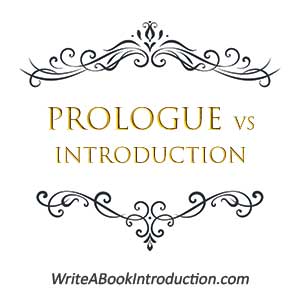What Is the Difference Between a Prologue and an Introduction?
 Understanding the difference between a foreword and an introduction is crucial for authors, collaborators, and readers alike. This article explores what makes a foreword different from an introduction, why each is used, and how they work together to frame a book. This article is part of a series about how to write a book introduction, written by a former literary agent who’s helped 400+ authors get literary agents and/or traditional publishers.
Understanding the difference between a foreword and an introduction is crucial for authors, collaborators, and readers alike. This article explores what makes a foreword different from an introduction, why each is used, and how they work together to frame a book. This article is part of a series about how to write a book introduction, written by a former literary agent who’s helped 400+ authors get literary agents and/or traditional publishers.
Prologue vs Introduction
A prologue is used in fiction to provide background, set the stage, or foreshadow events, written in the narrative style of the story. An introduction appears in nonfiction, explaining the book’s purpose, value, and structure, directly addressing the reader. Prologues focus on storytelling; introductions engage and inform readers.
Prologue vs. Introduction: What’s the Difference?
When starting a book, readers may encounter either a prologue or an introduction—or sometimes both. While these terms are often used interchangeably, they serve distinct purposes in storytelling and nonfiction writing. Understanding the difference between a prologue and an introduction can help authors decide which is appropriate for their book and guide readers in understanding their significance.
What Is a Prologue?
A prologue is a section that appears at the beginning of a story, usually in a novel or other works of fiction. It is used to provide background information, set the stage for the main story, or present events that occur before the book’s timeline.
Characteristics of a Prologue
- Fiction-Based: Prologues are almost exclusively used in fiction, rarely appearing in nonfiction works.
- Narrative in Style: They are written in the same voice and style as the main story.
- Purpose: Prologues offer important context or foreshadow events that will unfold later in the book.
- Optional for Readers: Some readers skip prologues, diving straight into the main story, so the content should enhance but not be critical to understanding the plot.
Common Uses of Prologues
- Foreshadowing: Hints at key events or conflicts that will occur later in the story.
- Backstory: Provides historical or character background that is important but doesn’t fit seamlessly into the main narrative.
- Mystery/Intrigue: Creates suspense or poses questions to hook the reader.
Example of a Prologue
- George R.R. Martin’s A Game of Thrones: The prologue introduces the White Walkers, setting up a key threat before the main story begins.
- Mary Shelley’s Frankenstein: The prologue presents letters from an Arctic explorer, framing Victor Frankenstein’s story.
Key Differences Between a Prologue and an Introduction
- Used In: A prologue is used in fiction; an introduction is used in nonfiction.
- Purpose: A prologue provides background or foreshadows events; a book introduction explains the book’s purpose and content.
- Voice: A prologue is narrative and matches the story’s tone; an introduction is authorial and directly addresses the reader.
- Focus: Prologues are story-focused; book introductions are reader-focused.
- Necessity: A prologue is optional for understanding the story; an introduction is essential for understanding the book’s purpose.
- Content: A prologue includes backstory, foreshadowing, or sets the scene; a book introduction establishes the purpose, themes, and structure of the book.
When to Use a Prologue
A prologue is appropriate if:
- You Need to Provide Context: If your story’s backstory or world-building is crucial but doesn’t fit naturally into the narrative, a prologue can provide it.
- You Want to Create Intrigue: A prologue can introduce a mystery or key event that keeps readers curious.
- You’re Writing in a Complex Timeline: If events from a different time or perspective need to be established before the main plot, a prologue can help.
Tips for Writing a Prologue
- Keep it short and relevant to the story.
- Avoid overloading with exposition; focus on a specific purpose.
- Ensure it enhances, rather than distracts from, the main plot.
When to Use an Introduction
An introduction is ideal if:
- You’re Writing Nonfiction: Readers need to understand the book’s purpose, relevance, and structure upfront.
- You Need to Hook the Reader: Use an engaging anecdote or statement to capture attention.
- You’re Presenting Complex Ideas: An introduction helps readers navigate academic, technical, or specialized content.
Tips for Writing an Introduction
- Start with a strong hook to grab attention.
- Clearly define the book’s purpose and value.
- Offer a roadmap, but avoid giving away too much detail.
Can a Book Have Both?
Yes, a book can have both a prologue and an introduction, though it’s rare. This usually happens when:
- A Fiction Book Includes an Introduction: To provide historical or cultural context for the story, in addition to a narrative prologue.
- A Nonfiction Book Includes a Prologue: If the nonfiction work includes a narrative element, such as a memoir or true crime story, the prologue might present a key event or story excerpt.
Conclusion – Prologue vs Introduction
While both prologues and introductions serve as openings, they cater to different genres and functions. A prologue sets the stage for a story, providing narrative context or intrigue, while an introduction engages readers in nonfiction, explaining the book’s purpose and value. Understanding these differences ensures that writers use the right tool to connect with their audience effectively. Whether you’re crafting fiction or nonfiction, a thoughtful opening will prepare your readers for the journey ahead.
Now that you’ve read “Prologue vs Introduction,” click here for the next article about how to write a book introduction, “The History and Evolution of Book Introductions.”


 This guide about
This guide about 